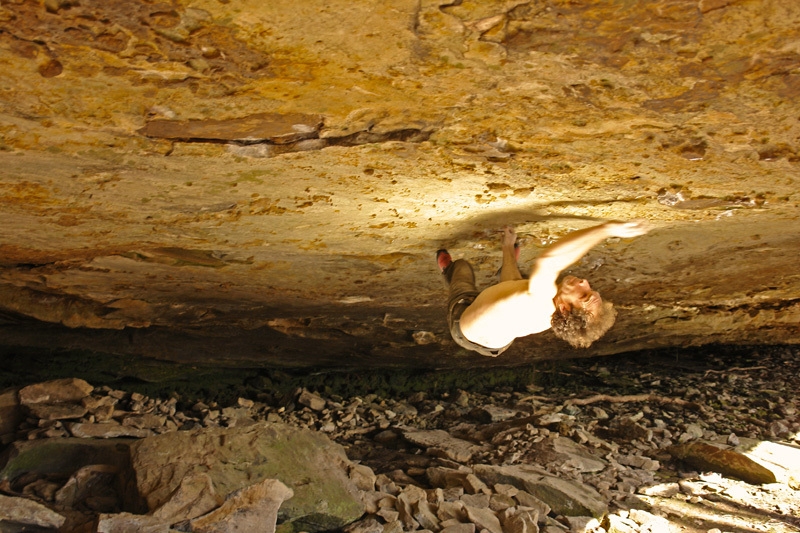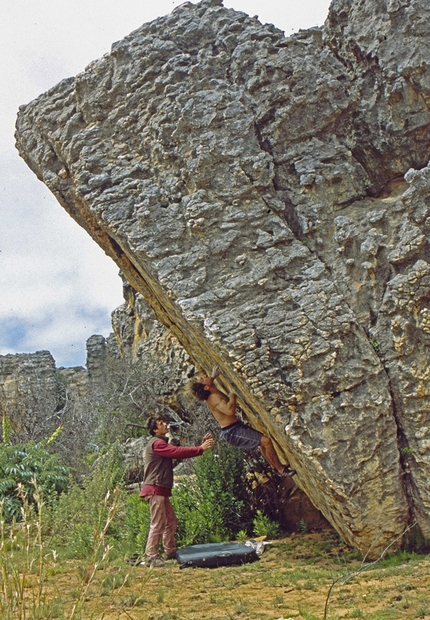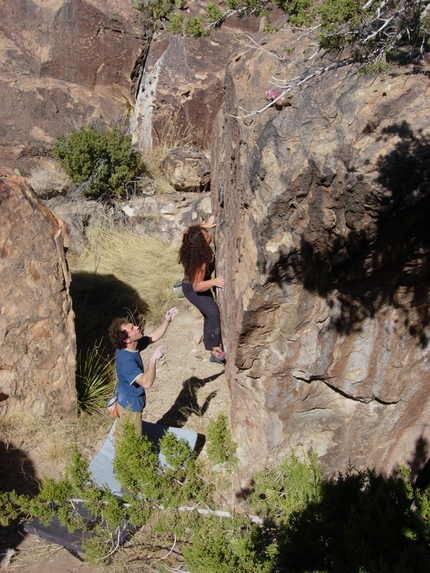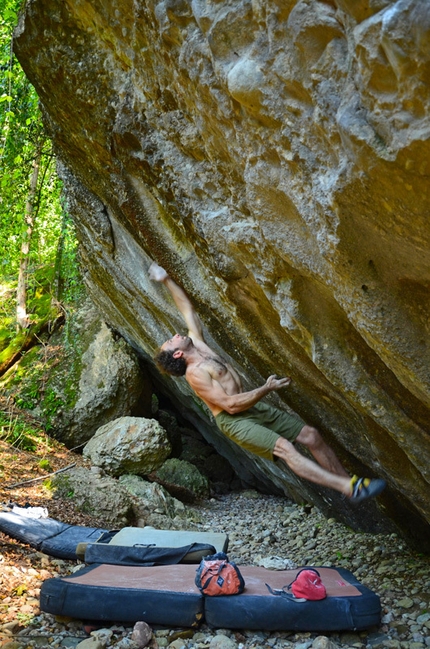Fred Nicole, the bouldering interview

 1 / 6
1 / 6 Fred Nicole archive
Fred Nicole archive
There are no two ways about it: think of bouldering and Fred Nicole immediately springs to mind. Ever since he first started bouldering in 1987 together with his brother François, there have been few climbers who have dominated and influenced this tight-knit scene as convincingly and consistently as Frédéric and the countless beautiful and difficult problems put up all across the globe during the last quarter of a century are testament to the Swissman's vision and ability.
As it happens, Nicole also has an excellent track record in sport climbing – he shocked the scene in 1987 when, a mere 16 and still unknown, along with his brother he repeated Patrick Berhault's Le toit d’Auguste, an 8b+considered to be one of the hardest routes at the time. And six years later he was still up there, at the very top, establishing the world's third 9a, the fearful slabBain de Sang.
But his main love remains linked to a crashpad and toothbrush, and important stepping stones obviously include La danse des Balrogs, the world's first 8B in 1992 and Radja, the world's first 8B+ four years later. This boundary was extended further still at the turn of the millennium with Dreamtime at Cresciano, which first broke into the mythical and unheard of 8C grade and, a bit like Midnight Lightening at Yosemite in its heyday, has come to represent a benchmark, must-do problem for the best of the best.
25 years down the line, Fred Nicole's vertical search continues to this day. In the forest. In the desert. Fontainebleau, Hueco, Cresciano, Rocklands, India. Wherever. The name of his game is exploring, together with his life partner Mary Gabrielli. In harmony with nature, as respectful as possible.
Fred, you've been climbing for over a quarter of a century...
Yes, but I've always had other interests beside climbing and bouldering such as drawing, painting, reading and even writing a little. I’m also worried and concerned about the current environmental situation as well as the social and humanitarian issues we are facing in this world. I think that we are living through crucial times and we need some new values to evolve.
Well, you've immediately put things into a wider perspective
I try to be active, by avoiding plastic, recycling as much as possible, using public transport, trying to drive with at least one passenger in a car (I suppose most of the time I’m the passenger). There can be no doubt that we have to reduce our impact on a global scale. I support some organisations such as ”Greenpeace”, ”WWF”, ”Terre des hommes”, and a few other activist groups. On a climbing scale of things we can do a lot. Obvious things like following trails to minimise erosion, taking all our trash back (cigarettes, toilet paper, plastic bags, bottles etc.). We should be careful when cleaning boulders, not cut down entire trees just to do a new line...
You've climbed plenty of new lines. Tell us about your beginnings
My brother François first brought me to the rock in 1983, freeclimbing wasn't really developed back then in our region. During the early years we experimented in mountaineering, sport climbing and some kind of bouldering, but this was used more as a type of training. The first time on real boulders was a few years later in Wallis, in 1987 with Lucien Abbet, an iconic climber from there who showed me Branson and a few other spots. The local climbers had already been bouldering very actively for years and this was one of the first times I saw real boulder problems. Before that I'd been more into traversing, doing some some eliminating games and buildering.
In Wallis I had the chance to meet a real climbing scene: the driving force was Filou Scherrer, a great person and climber from Geneva very active back then. Unfortunately he died a few years later with his brother Mark in a massive snow & ice avalanche at Peak Lenin in Pamir where 43 people lost their lives. Of course other people played an important role in my early development, too: Kidet (still really active and always looking for new rocks), the infamous Peponne, the Scottish Graeme Livingstone who taught us the British way of bouldering, Benoit Dorsaz and many more. Their experience contributed to widening our vision of what climbing could be.
Which rapidly rresulted in La Danse des Balrogs, the world's first 8B
La danse is on a specialy steep face on one of the main boulder in Branson. We all considered this crazy overhang, it looked futuristic but at the same time somehow possible. I went back a few times but mainly to climb the existing lines since at the time we were more into rope climbing. In 1989 we started trying some moves on this intriguing face and this resulted in the first modern problem, La traction céleste stand up, graded 7B+. One year later the sitdown was added at 8A. Two more years went by and then along came La danse des Balrogs and finaly Radja in 1996. It was not only an important time because these were the first boulders I established in these grades, but above because of the people we met and the great moments we were lucky to experience there.
In 2000 along came Dreamtime, the world's first 8C. A dream or perhapsan obsession?
No, Dreamtime was not a particular obsession for me. It was more like a logical progression culminating from a period of bouldering in Ticino. To my eyes it represents, thanks to the purity of the line and the beauty of the boulder, the best of what this type of rock can offer.
In that same year you also established Oliphant's Dawn in Rocklands, a problem which is in the limelight now thanks to Nalle Hukkataival's recent rpeat..
It's a really cool problem I opened in September 2000. Three hard moves, the first one being the hardest of them with a real special gaston crimp. For the grade, I'm not sure since the effort is so short. But it is certainly one of the hardest single moves I've ever done. Conditions are really important for this climb: the place is hot and sunny and I did it really early one morning during what was one of my best years of bouldering. It's great that Nalle Hukkataival has now repeated it!
You started, and also continue, to climb with a rope. Bain De Sang from back in 1993 springs to mind...
Yes, I still go rope climbing. It doesn't suit me as much as bouldering - I'm too scared - but sometimes I can still enjoy it. Both activities are really connected in my mind, even if I boulder more than I sport climb. Bain de Sang is connected to my roots since St. Loup is one of the places where I started climbing. It's cool to look back and try to retrace the long way from my first 5th grade route to the doors of the 9th grade. Bain de sang feels like a benchmark for me, in relation to other routes in St. Loup (until 1993), just like Dreamtime in Ticino…
In recent years bouldering has exploded in popularit which is a good thing, but the downside is that some areas are increasingly at risk of closure.
The areas that are closed, or at risk of closure, tend to be located on private land or under national/regional protection (i.e. parks) and the owners and managers are simply not prepared for the increase in the number of climbers. So it’s not that we're necessarily doing something wrong, it’s just that these are are not ready for this increasing number of visitors (in a really short time) and their logical impact. At least in Europe we should get organised to avoid situations like these, maybe to create an equivalent of the Access Fund like in the US would be a good idea. We can’t just impose our presence, we need to discuss with the people and organisations concerned and be aware of their point of view and respect it.
In Cresciano last winter you were astonished by how many climbers there were. In all honesty, did this really surprise you?
It is hard to tell, because in the early days of bouldering in Ticino we were a really small group of people. The other climbers laughed at us and didn`t show any kind of real interest in our actions. Back then a few boulderers from other countries visited Ticino and some told us that it wasn’t interesting enough to attract a big crowd. Ironically the big bouldering boom came just after that.
We remember that you established a beautiful new problem by simply walking for a bit until all of a sudden you were completely alone...
It was during New Year, so it is quite normal that the place was busy. I have no criticism about that, it is just a big contrast compared to the time (not so long ago in my mind) when we were used to being alone in that forest. But most of the climbers were concentrated in particular area and after sector “La Boule” the forest was totally quiet...
The forest has also been the scene of chipping. Is this a thing of the past?
Unfortunately it is not, even if it is probably a bigger problem in sport climbing than bouldering. Yes, chipping is still going on and I remain firm in my position; it is nonsense to chip when you practice free climbing. By definition the goal is to seek a line and look for the possible holds which may or may not bring you to the top. You need patience, observation and adaptability. Chipping seems more like adapting the environment to your own needs.
Recently problems are becoming higher and there are more and more crashpads.
Although this seems to be one direction bouldering is going, it is not exactly my quest. But it is impressive what some are achieving in this style!
Cresciano, Hueco, Rocklands, India... you are famous for establishing new problems. But what about repeating those of others?
Even if I'm more into discovering new lines and places, I also like to repeat existing problems. When a line is nice and inspiring it's as exiting to repeat it, as it is to establish something new. Let me give a few examples: -Kryptos 8C from Widmer, The Swarm V14, The spectre V13, Goldfish V14, Satan L'hélvète 8B, New Base line 8B+, Witness the Fitness, Derailed 8B/B+, Ray of Light 8B, Ammagama V13, etc… If I’m in a new place though then the only choice I have is to open new lines. And this is one of the things I like most!
So what must a problem have to be beautiful?
There are no specific rules to define a beautiful problem. A sit down start can be great and can climb much better than any stand-up and vice-versa. It's a subjective choice in my opinion; all rocks are a gift from mother earth. Every boulder is so different and offers so many possibilities that it's impossible to define what make it worth climbing and what doesn't.
When you pack your rucksack and set off with your crashpad, what is your golden bouldering rule?
I don’t have the golden rule! Everyday is so different! What I try to do everywhere is to be aware of our environment and other human beings. I suppose my message is: be as open minded and respectful as possible!
Fred Nicole's climbs: a non-exhaustive choice from the beginning.
1983 – I start climbing with my brother François in Eclèpens, first 3+ (no name).
1987- Le toit d’Auguste 8b+ route Loubière France.
1989 - La vie, l’univers et le reste 8c route at St-Loup.
1990 - La traction céleste 8a boulder Branson.
1992 - La danse des Balrogs 8b boulder Branson
1993 - Bain de Sang 9a route St-Loup. First trip to the US.
1994 - E la nave va 8c traverse, Lindental.
1995 - Broadsword 8b+/c traverse Lindental, The crown of Aragorn v13 at Hueco, Dominator 8a+/b in a day Yosemite, Karma 8a in Font.
1996 - Radja 8b+ boulder, Branson. first trip to Rockland: Black Eagle Stand –up 8a+, Leopard cave 8a+ , Pendragon 8a flash, Tai chi 8a.
1997 - Li v13, Slashface v13/14 at Hueco.
1998 - Coeur de Léon v14 at Hueco, La pierre philosophale 8b in Font.
1999 - Fatman sitdown 8b boulder at Font.
2000 - Nunjanuka 8b Armidale Australia, Oliphant’s Dawn 8b/c at Rockland, Dreamtime 8c in Cresciano.
2001 - Goldfish v14 at Bishop, Esperanza v14 Hueco.
2002 - La Chimère 9a+ route, St-Loup. Black Eagle sitdown 8C boulder, Monkey Weading 8c boulder, both at Rockland, Le galet 8b boulder in Murg.
2003 - Massive attack 8a+/b flash, New Base Line 8b+ both at Avers. Madiba 8b+, Mooiste Meisie 8b+ both in Rockland.Nagual V13, Hueco.
2004 - Le poinçonneur des Lilas 8c boulder in Baslerjura, Golden Shadow 8b+/c.
2005 - Entlinge 8c boulder in Murg. Amandla 8c boulder in Rockland, before the crux edge broke a bit and became slightly bigger. Terremer 8c at Hueco.
2006 - Witness the Fitness, Arkansas.
2007 - Ragtime 8b+ at Amden, Flanagan 8b in Murg, White stripe 8b at Brione.
2008 - Derailed 8b+ boulder, Quintessential 8b at Rockland.
2009 - L’Isola che non c’è in Amden, a hybrie boulder-route, a great hard line, maybe similar to a ninth grade sport climb, Kryptos 8c boulder In Balstal, The Swarm 8b at Bishop.
2011 - Le Boa 8c boulder in eastern Switzerland. Mandragore 8b+ boulder, Cuzzago. L’ombre du vent 8b boulder at Murg.Trice v12, Flagstaff.
Fred Nicole is sponsored by: Prana, Five Ten, Black Diamond and Arcteryx



 Copia link
Copia link





 See all photos
See all photos





















